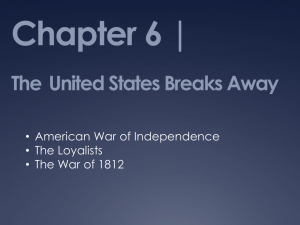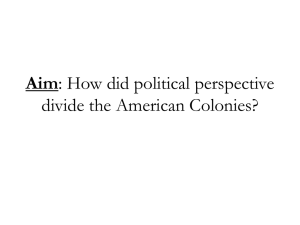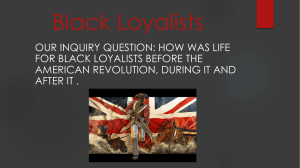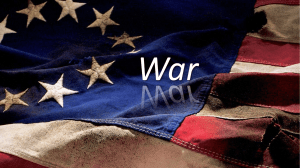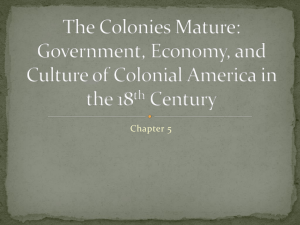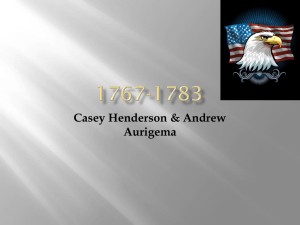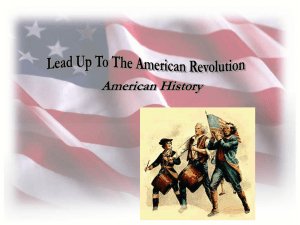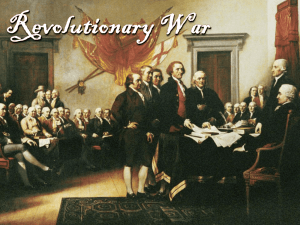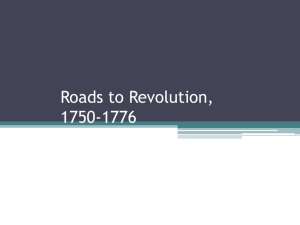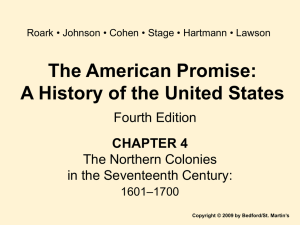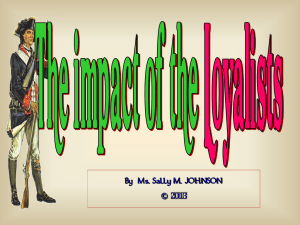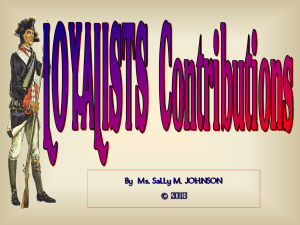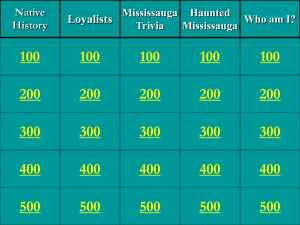Rebellion in the Thirteen Colonies
advertisement
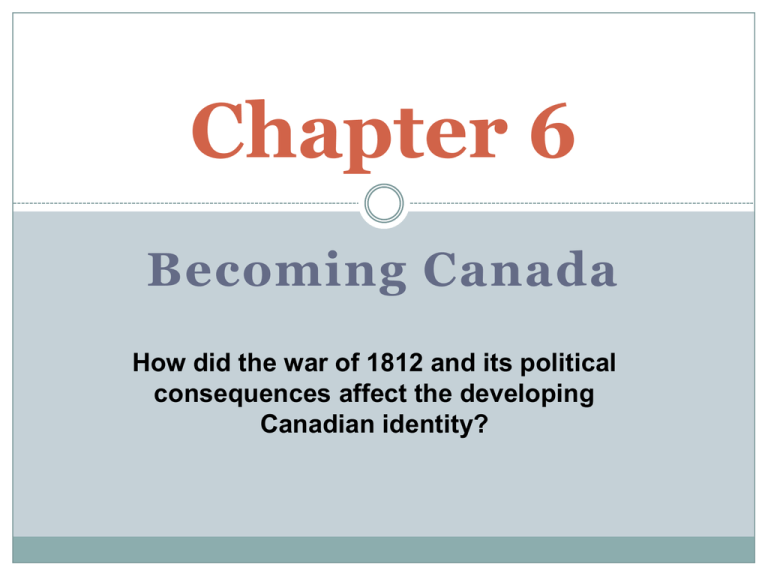
Chapter 6 Becoming Canada How did the war of 1812 and its political consequences affect the developing Canadian identity? Rebellion in the Thirteen Colonies Liberators: Someone who releases people from oppression, confinement, or foreign control. United Empire Loyalists: An inhabitant of the Thirteen Colonies who remained loyal to Britain during the American Revolution and fled to British North American colonies after 1776. Growing Restless: Invaders vs. Liberators By the late 1775, a rebellion exploded in Britain’s Thirteen Colonies because they were growing restless under British rule. The British government passed a number of laws that the colonists were not happy with including the Tea Act. Growing Restless: Invaders vs. Liberators THE TEA ACT The British East India Company had controlled all tea trading between India and the British colonies. In May 1773, the Tea Act was passed giving a tea monopoly to the British East India Company. The colonists were outraged with this law, that the dockworkers began refusing to unload the tea from ships. The Governor of Massachusetts demanded that the tea be unloaded. He also demanded that the people pay the taxes and duty on tea. Growing Restless: Invaders vs. Liberators THE TEA ACT What famous event from American History happened because of the Tea Act? Growing Restless: Invaders vs. Liberators The Boston Tea Party On the evening of December 16, 1773, a group of men calling themselves the "Sons of Liberty" went to the Boston Harbor dressed as Mohawks. They boarded three British ships and dumped fortyfive tons of tea into the Boston Harbor. The Boston Tea Party is seen as one of the first great acts of protest against the British government in the Thirteen Colonies. Growing Restless: Invaders vs. Liberators The Boston Tea Party Growing Restless Many things lead to the colonists growing restless in the thirteen colonies: 1. 2. 3. 4. They could trade only with their home country. They had to pay high taxes on British imports. They wanted to control over their own affairs. Britain passed the Quebec Act giving the Ohio Valley to Québec and not the Thirteen Colonies. The War of Independence April 1775 the first shots are fired in the American War of Independence. After many years of fighting it ended in 1783 with the British Government recognizing the United States of America. British North America (BNA) = all British colonies in North America other than the Thirteen Colonies. United States of America = the Thirteen Colonies QUESTIONS Rebellion in the Thirteen Colonies (pg 125-130) 1. a) What event does “the Suite Life of Zach and Cody” depict? (1pt) b) How is this connected to Chapter 6? (1 pt) 2. a) In what years did the American War of Independence begin and end? (2 pts) b) What happened at the end of the war? (1pt) Rebellion in the Thirteen Colonies Traitors: One who betrays one’s country, a cause or a trust. Refugees: A person who flees a country because he or she can no longer live in safety and in his or her own country because of war, torture, famine or persecution. Discrimination: Unfair treatment of a person or group based on prejudice. The United Empire Loyalists A loyalist is someone who lived in the Thirteen Colonies who remained loyal to Britain during the American Revolution. The United Empire Loyalists They had many reasons for opposing the war: some didn’t believe in using violence to settle disputes Some had business ties with the British. Some were in military regiments that had fought with the British. Some were enslaved African Americans seeking freedom. Some were First Nations peoples who had lost their land to Americans. The United Empire Loyalists The loyalists were treated as traitors As a consequence the Americans: Took away their property and possessions They beat and jailed them They painted them with hot tar, covered them with feathers and paraded them around town. As a result of the mistreatment: They were forced to flee north seeking shelter and safety as refugees. The United Empire Loyalists The loyalists were treated as traitors The Americans: Took away their property and possessions They beat and jailed them They painted them with hot tar, covered them with feathers and paraded them around town. The United Empire Loyalists As a result: The loyalists were forced to flee north seeking shelter and safety as refugees. The United Empire Loyalists contd. During and after the War of Independence, approx 40, 000 loyalists migrated to the British colonies, many travelled to Nova Scotia. Resulting in the doubling the population and the creation of new communities. The United Empire Loyalists contd. • How do you think the Loyalists were treated when they reached the British colonies? Discrimination Life was difficult for all the Loyalists. Britain helped them by giving them free land and supplies. Land went to those who had fought for Britain, others may not have received land at all. Discrimination Black Loyalists received: Less land Land that was not good for farming. Many had to work as tenant farmers – farming a plot of land and having to give half the money from the sale of their crops to landowners. What do you think the Black Loyalists did? Discrimination Despite the hardships of racism and discrimination, many Black Loyalists stayed and overcame the challenges to build a rich heritage in Nova Scotia. New Colonies Many Loyalists were unhappy in Nova Scotia, they wanted their own colony. In 1784 Britain agreed NS was divided into two parts. Western Portion became New Brunswick Cape Breton Island became a new colony. Ile Saint-Jean was renamed Prince Edward Island. Loyalists in Québec Loyalists also streamed North in Québec crowding into temporary camps waiting for Britain to help them. Many Loyalists didn’t want to settle in Québec because the French Language and Catholic traditions were unfamiliar to them and all the good land was already taken. What does the Figure 6.8 on page 128 tell you about the Loyalist experience? A Fair Trade? The Governor of Québec, Sir Frederick Haldimand, agreed to give the newcomers land further west in 1784. This land had belonged to the Anishinabe, the governor had bought it in 1781/1783. He paid for it with some guns and other trading goods. Why do you think the Anishinabe gave up so much land for such a small price? A Fair trade? 1. The Anishinabe did not realise they were selling the land. They thought they were giving him permission to use the land. By the time they realised what had happened it was too late. 2. Fear. They may have been to afraid to say no to the governors. Would the British use force to take their land like the French had? Building a Bilingual Country Québec was now populated by both English and French speaking people with different traditions and customs. The Canadiens formed the majority but the Loyalists wanted to keep their own heritage. What would the Loyalists need in order to be able to do this? Building a Bilingual Country Québec was now populated by both English and French speaking people with different traditions and customs. The Canadiens formed the majority but the Loyalists wanted to keep their own heritage. What would the Loyalists need in order to be able to do this? Their own colony and institutions. Building a Bilingual Country In 1791, the Constitutional Act divided Québec into two: Upper and Lower Canada. Each colony had an elected assembly. The Citizens of Québec kept all the rights they had gained from the Québec Act in 1774. This allowed the French and English to co-exist. QUESTIONS 1. Explain how not all loyalists were treated fairly when they reached Nova Scotia. (3 pts)
